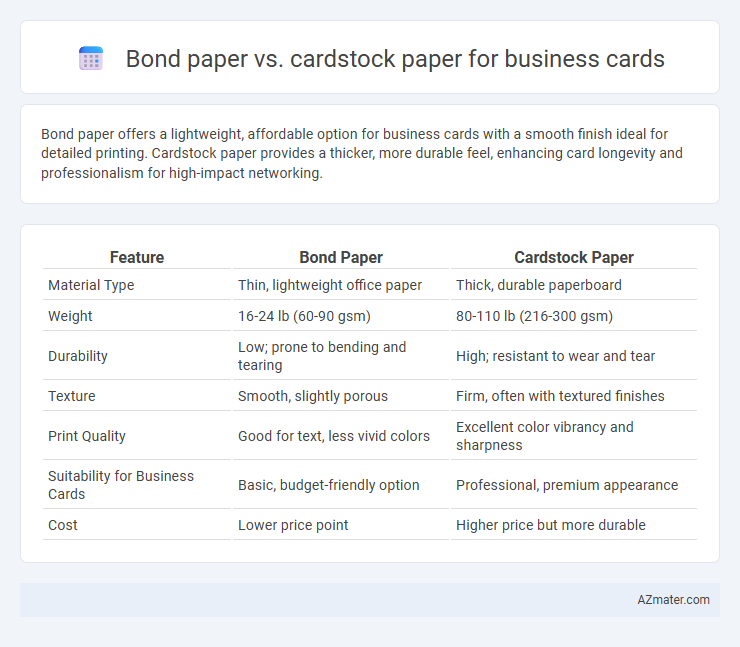Bond paper offers a lightweight, affordable option for business cards with a smooth finish ideal for detailed printing. Cardstock paper provides a thicker, more durable feel, enhancing card longevity and professionalism for high-impact networking.
Table of Comparison
| Feature | Bond Paper | Cardstock Paper |
|---|---|---|
| Material Type | Thin, lightweight office paper | Thick, durable paperboard |
| Weight | 16-24 lb (60-90 gsm) | 80-110 lb (216-300 gsm) |
| Durability | Low; prone to bending and tearing | High; resistant to wear and tear |
| Texture | Smooth, slightly porous | Firm, often with textured finishes |
| Print Quality | Good for text, less vivid colors | Excellent color vibrancy and sharpness |
| Suitability for Business Cards | Basic, budget-friendly option | Professional, premium appearance |
| Cost | Lower price point | Higher price but more durable |
Understanding Bond Paper and Cardstock Paper
Bond paper for business cards is a lightweight, smooth-textured material typically used for everyday printing, offering affordability and ease of handling but less durability. Cardstock paper, thicker and more rigid with a weight usually starting at 80 lb, provides a premium feel and enhanced sturdiness, making it ideal for professional business cards that require longevity and standout quality. Understanding these distinctions helps businesses choose between economical options and high-impact presentation materials based on their branding needs.
Key Differences Between Bond Paper and Cardstock
Bond paper typically has a lighter weight, around 16 to 24 pounds, and a smoother surface that suits professional printing and writing, making it an economical choice for business cards. Cardstock is heavier and thicker, often ranging from 50 to 110 pounds, providing greater durability and a more substantial feel that enhances the card's perceived quality and longevity. The key differences lie in weight, thickness, and texture, with cardstock offering premium rigidity and bond paper delivering cost-effective versatility for business card printing.
Thickness and Durability Comparison
Bond paper typically ranges from 16 to 24 lb in weight, offering moderate thickness and a smooth texture, which suits everyday business card printing needs but lacks high durability. Cardstock paper ranges from 65 to 110 lb or more, providing significantly greater thickness and sturdiness, ensuring business cards maintain their shape and resist wear over time. Choosing cardstock enhances durability and professional appearance for business cards due to its rigid structure compared to the thinner, less resilient bond paper.
Print Quality on Bond Paper vs Cardstock
Cardstock paper offers a thicker, more durable surface that enhances print quality for business cards by providing sharper images and richer colors compared to bond paper. Bond paper, being thinner and more porous, tends to absorb ink, leading to less vibrant and slightly blurred prints. For professional business cards requiring crisp text and high-resolution graphics, cardstock is the preferred choice due to its superior weight and texture that support high-quality printing.
Professional Appearance and Feel
Cardstock paper offers a thicker, more durable feel that conveys professionalism and quality, making business cards stand out with a substantial, premium texture. Bond paper, while smoother and lighter, often appears less formal and can be perceived as flimsy compared to cardstock. Choosing cardstock enhances the visual impact and tactile impression, reinforcing a strong professional image for business cards.
Cost Effectiveness for Business Cards
Bond paper offers a cost-effective option for business cards due to its lower price per sheet and compatibility with standard printers, making it ideal for bulk printing on a budget. Cardstock paper, while more expensive, provides enhanced durability and a premium feel that can justify the higher cost by improving brand perception. Businesses must weigh initial printing expenses against long-term impact and usage frequency to determine the most economically viable choice.
Suitability for Various Printing Techniques
Bond paper offers smooth, absorbent surfaces ideal for inkjet and laser printers, making it suitable for high-detail text and graphics on business cards. Cardstock, with its thicker and sturdier composition, supports embossing, foil stamping, and letterpress techniques, providing enhanced durability and a premium tactile feel. For professional business cards requiring vibrant colors and special finishes, cardstock is preferred, while bond paper fits budget-friendly, standard print jobs.
Environmental Impact and Sustainability
Bond paper for business cards generally has a lower environmental impact due to its thinner composition and higher recyclability, often made from recycled fibers or sustainably sourced wood pulp. Cardstock paper, while thicker and more durable, typically requires more raw materials and energy in production, which can increase its carbon footprint despite offering longer usability. Choosing recycled or FSC-certified options for either type significantly enhances sustainability by reducing deforestation and waste.
Popular Choices for Business Card Material
Bond paper and cardstock are popular choices for business card material, with cardstock favored for its thickness and durability, typically ranging from 80 lb to 110 lb cover weight, providing a professional feel. Bond paper is thinner and more affordable, often used for lightweight business cards but may lack the rigidity that makes cardstock ideal for lasting impressions. Many businesses prefer cardstock to convey quality and sturdiness, while bond paper suits budget-conscious projects requiring high print clarity.
Choosing the Right Paper for Your Business Card
Choosing the right paper for your business card depends on durability and impression. Bond paper offers a lightweight, smooth finish ideal for simple, cost-effective cards, while cardstock provides a thicker, sturdier feel that conveys professionalism and quality. Opting for cardstock enhances visual impact and longevity, making it the preferred choice for creating memorable business cards.

Infographic: Bond paper vs Cardstock paper for Business card
 azmater.com
azmater.com